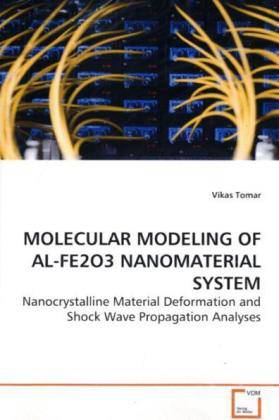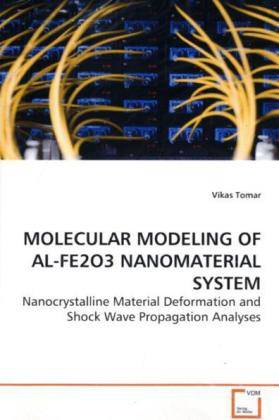
Je cadeautjes zeker op tijd in huis hebben voor de feestdagen? Kom langs in onze winkels en vind het perfecte geschenk!
- Afhalen na 1 uur in een winkel met voorraad
- Gratis thuislevering in België vanaf € 30
- Ruim aanbod met 7 miljoen producten
Je cadeautjes zeker op tijd in huis hebben voor de feestdagen? Kom langs in onze winkels en vind het perfecte geschenk!
- Afhalen na 1 uur in een winkel met voorraad
- Gratis thuislevering in België vanaf € 30
- Ruim aanbod met 7 miljoen producten
Zoeken
MOLECULAR MODELING OF AL-FE2O3 NANOMATERIAL SYSTEM
Nanocrystalline Material Deformation and Shock Wave Propagation Analyses
Vikas Tomar
Paperback | Engels
€ 107,45
+ 214 punten
Omschrijving
One of the recent advances in materials science has
focused on developing materials that have two or
more crystalline systems mixed at the nanoscale.
Until now, the development and the analyses of such
materials have primarily been experimental.
In the current research, a framework based on
classical molecular dynamics (MD) is developed for
analyzing deformation mechanisms in nanostructural
materials consisting of more than one crystalline
system. The material system of focus is a
combination of fcc-Al and -Fe2O3. The framework
includes the development of an interatomic
potential, a scalable parallel MD code,
nanocrystalline composite structures, and
methodologies for the quasistatic and dynamic
strength analyses. The framework is applied to
analyze the nanoscale mechanical behavior of the
Al+Fe2O3 material system in two different settings.
First, quasistatic strength analyses of
nanocrystalline composites with average grain sizes
varying from 3.9 nm to 7.2 nm are performed. Second,
shock wave propagation analyses in single
crystalline Al, Fe2O3, and one of their interfaces
are carried out.
focused on developing materials that have two or
more crystalline systems mixed at the nanoscale.
Until now, the development and the analyses of such
materials have primarily been experimental.
In the current research, a framework based on
classical molecular dynamics (MD) is developed for
analyzing deformation mechanisms in nanostructural
materials consisting of more than one crystalline
system. The material system of focus is a
combination of fcc-Al and -Fe2O3. The framework
includes the development of an interatomic
potential, a scalable parallel MD code,
nanocrystalline composite structures, and
methodologies for the quasistatic and dynamic
strength analyses. The framework is applied to
analyze the nanoscale mechanical behavior of the
Al+Fe2O3 material system in two different settings.
First, quasistatic strength analyses of
nanocrystalline composites with average grain sizes
varying from 3.9 nm to 7.2 nm are performed. Second,
shock wave propagation analyses in single
crystalline Al, Fe2O3, and one of their interfaces
are carried out.
Specificaties
Betrokkenen
- Auteur(s):
- Uitgeverij:
Inhoud
- Aantal bladzijden:
- 240
- Taal:
- Engels
Eigenschappen
- Productcode (EAN):
- 9783639158588
- Verschijningsdatum:
- 21/05/2009
- Uitvoering:
- Paperback
- Afmetingen:
- 152 mm x 229 mm
- Gewicht:
- 358 g

Alleen bij Standaard Boekhandel
+ 214 punten op je klantenkaart van Standaard Boekhandel
Beoordelingen
We publiceren alleen reviews die voldoen aan de voorwaarden voor reviews. Bekijk onze voorwaarden voor reviews.









